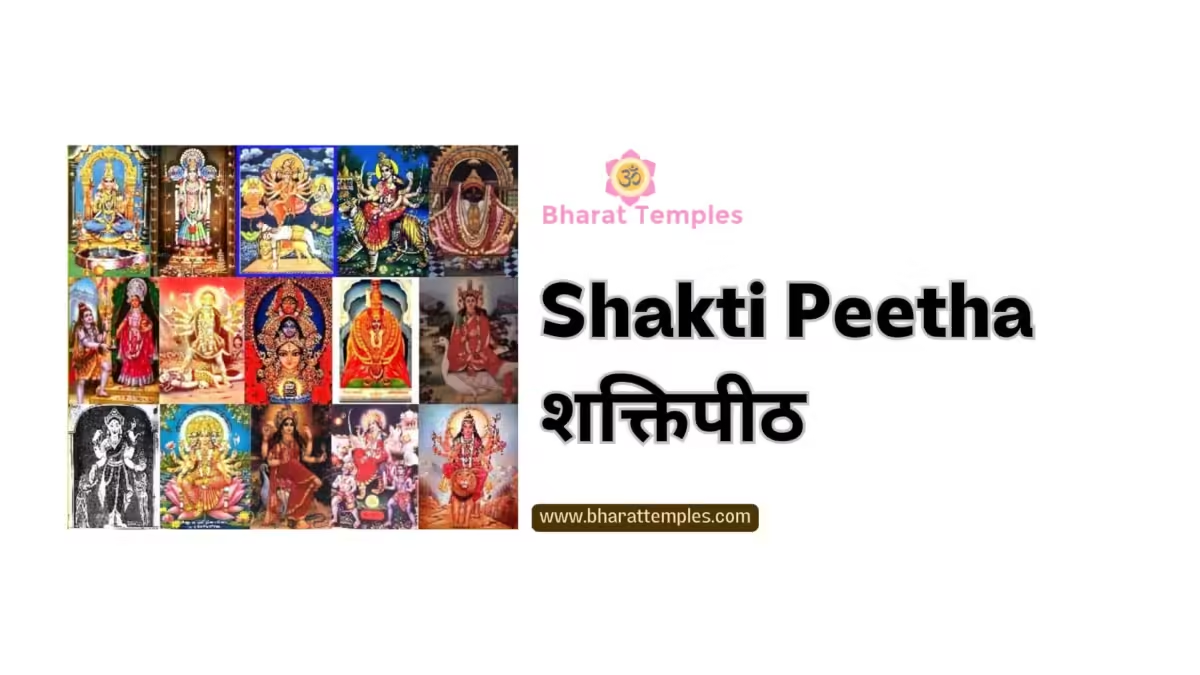Contents
The concept of Shakti Peeths is a significant aspect of Hindu mythology, representing sacred sites where the body parts of Goddess Sati, the consort of Lord Shiva, are believed to have fallen after her self-immolation.
Shakti Peetha
These sites are revered as powerful embodiments of the Divine Feminine energy, symbolizing strength, creativity, and spiritual awakening.
Historical and Mythological Background
According to legend, after Sati’s death, Lord Shiva was engulfed in grief and performed the Tandava, a dance of destruction. To calm him, Lord Vishnu used his Sudarshan Chakra to dismember Sati’s body, scattering her parts across various locations on Earth. These locations became known as Shakti Peeths, each representing a unique aspect of the Goddess’s energy and serving as pilgrimage sites for devotees seeking blessings, protection, and empowerment from the Divine Mother
Spiritual Significance
Shakti Peeths are not merely physical temples; they are considered portals to divine energy, allowing devotees to connect deeply with the cosmic power of the Goddess. Each Peeth is believed to possess unique vibrations that can awaken the dormant Shakti within individuals, facilitating spiritual growth and self-realization. Engaging in rituals such as aarti and offering flowers or fruits enhances the sacred atmosphere and fosters a deeper connection with the divine.
Pilgrimage and Practices
Visiting Shakti Peeths is seen as a transformative spiritual journey. Pilgrims often face various challenges on their way, which metaphorically represent the obstacles one must overcome in their spiritual path. The act of pilgrimage encourages devotees to surrender to the divine energy of the Goddess, promoting inner exploration and self-discovery.
List of 51 Shakti Peethas
| No. | Shakti Peetha | Location | Body Part / Ornament |
|---|---|---|---|
| 1 | Kamakhya | Guwahati, Assam, India | Yoni (Vulva) |
| 2 | Kalighat | Kolkata, West Bengal, India | Right Toes |
| 3 | Tarapith | Birbhum, West Bengal, India | Third Eye |
| 4 | Bakreshwar | Birbhum, West Bengal, India | Portion Between Eyebrows |
| 5 | Bhawanipur | Bhawanipur, Bangladesh | Left Anklet |
| 6 | Jaintia | Sylhet, Bangladesh | Left Thigh |
| 7 | Jessoreswari | Ishwaripur, Bangladesh | Left Palm |
| 8 | Chhinnamastika | Chintpurni, Himachal Pradesh, India | Head |
| 9 | Naina Devi | Bilaspur, Himachal Pradesh, India | Eyes |
| 10 | Vishalakshi | Varanasi, Uttar Pradesh, India | Earring |
| 11 | Manikarnika | Varanasi, Uttar Pradesh, India | Ear Ornament |
| 12 | Lalita Devi | Prayagraj, Uttar Pradesh, India | Finger |
| 13 | Kalmadhav | Allahabad, Uttar Pradesh, India | Heart |
| 14 | Jwalamukhi | Kangra, Himachal Pradesh, India | Tongue |
| 15 | Ambaji | Gujarat, India | Heart |
| 16 | Hinglaj | Hingol, Pakistan | Brahmarandhra (Top of Head) |
| 17 | Kireet | Kireetkona, Bangladesh | Crown |
| 18 | Sugandha | Shikarpur, Bangladesh | Nose |
| 19 | Attahas | Labhpur, West Bengal, India | Lips |
| 20 | Maa Ugratara | Udaipur, Tripura, India | Little Finger |
| 21 | Tripura Sundari | Tripura, India | Right Leg |
| 22 | Jayanti | Alipurduar, West Bengal, India | Left Thigh |
| 23 | Chattala | Chittagong, Bangladesh | Right Arm |
| 24 | Karnat | Karnataka, India | Ear Ornament |
| 25 | Bhairavparvat | Madhya Pradesh, India | Upper Lip |
| 26 | Varanasi | Varanasi, Uttar Pradesh, India | Earrings |
| 27 | Pushkar | Ajmer, Rajasthan, India | Wrist Bracelet |
| 28 | Sharada Peeth | Neelum Valley, Pakistan | Right Hand |
| 29 | Gandaki | Nepal | Teeth |
| 30 | Yugadya | Bengal, India | Right Arm |
| 31 | Muktinath | Nepal | Temple |
| 32 | Mahalakshmi | Kolhapur, Maharashtra, India | Eyes |
| 33 | Shardha Peeth | Kashmir, India | Right Hand |
| 34 | Sarvamangala | Kolar, Karnataka, India | Stomach |
| 35 | Vaidyanath | Deoghar, Jharkhand, India | Heart |
| 36 | Kamakhya | Guwahati, Assam, India | Yoni (Vulva) |
| 37 | Chamundeshwari | Mysore, Karnataka, India | Hair |
| 38 | Jogulamba | Alampur, Telangana, India | Upper Teeth |
| 39 | Yadagirigutta | Yadadri, Telangana, India | Right Arm |
| 40 | Baidyanath | Deoghar, Jharkhand, India | Heart |
| 41 | Belur | Murshidabad, West Bengal, India | Ankle Ornament |
| 42 | Bhadrakali | Warangal, Telangana, India | Left Cheek |
| 43 | Biraja | Jajpur, Odisha, India | Navel |
| 44 | Girija | Nepal | Right Arm |
| 45 | Mangalagauri | Gaya, Bihar, India | Breast |
| 46 | Narayana | Amarkantak, Madhya Pradesh, India | Chin |
| 47 | Purnagiri | Tanakpur, Uttarakhand, India | Navel |
| 48 | Shree Shailam | Andhra Pradesh, India | Necklace |
| 49 | Tara Tarini | Berhampur, Odisha, India | Breast |
| 50 | Tripureshwari | Tripura, India | Right Foot |
| 51 | Ujaani | Gauriganj, Assam, India | Back Part |
Each site is believed to be associated with a part of Sati’s body or her ornaments, which fell to Earth during the Tandava dance of Shiva.
Festivals at Shakti Peeths
Visiting Shakti Peeths, sacred sites dedicated to the Hindu Goddess Shakti, is a significant pilgrimage for devotees seeking blessings, spiritual growth, and connection with the divine feminine energy. These pilgrimages are often marked by festivals and rituals that celebrate the power and manifestations of the Goddess.
Pilgrimage Practices
Pilgrimage to Shakti Peeths involves various practices and traditions that enhance the spiritual experience:
- Chanting mantras and hymns dedicated to the Goddess
- Offering flowers, fruits, and other auspicious items to the deities
- Participating in aarti ceremonies, where devotees offer light to the Goddess
- Circumambulating the temple and the sanctum sanctorum
- Fasting and abstaining from certain foods as a form of penance and purification
- Seeking blessings from priests and holy men at the temple
Major Festivals
Shakti Peeths celebrate numerous festivals throughout the year, each with its unique significance and rituals:
- Navaratri (September-October): This nine-night festival is dedicated to the Goddess in her various forms. Special pujas, fasts, and cultural programs are organized during this time.
- Durga Puja (October): Celebrated with great fervor in West Bengal and other parts of India, this festival marks the victory of Goddess Durga over the demon Mahishasura.
- Diwali (October-November): The festival of lights is also celebrated at Shakti Peeths, with the lighting of lamps and exchange of sweets.
- Maha Shivaratri (February-March): This festival honors the divine union of Shiva and Shakti. Devotees offer prayers and perform rituals at Shakti Peeths.
- Chaitra Navaratri (March-April): Similar to Navaratri, this nine-night festival is celebrated in the month of Chaitra (March-April).
- Dussehra (September-October): Marking the victory of good over evil, this festival is celebrated with great enthusiasm at Shakti Peeths.
- Kali Puja (October-November): Dedicated to Goddess Kali, this festival is celebrated with special pujas and rituals at Shakti Peeths like Kalighat in Kolkata.
These festivals not only attract devotees but also showcase the rich cultural heritage associated with Shakti Peeths. Pilgrims often participate in cultural programs, such as dance and music performances, that add to the festive atmosphere.
Also Read
FAQs
Shakti Peeths are sacred sites in Hinduism where the body parts of Goddess Sati are believed to have fallen after her self-immolation. They are revered as embodiments of the Divine Feminine energy and powerful spiritual centers.
There are traditionally 51 recognized Shakti Peeths, with the majority located in India. Other Shakti Peeths are found in neighboring countries like Bangladesh, Nepal, Pakistan, and Sri Lanka.
Shakti Peeths are considered portals to divine energy, allowing devotees to connect deeply with the cosmic power of the Goddess. They are believed to possess unique vibrations that can awaken the dormant Shakti within individuals, facilitating spiritual growth and self-realization.
Major festivals celebrated at Shakti Peeths include Navaratri, Durga Puja, Diwali, Maha Shivaratri, Chaitra Navaratri, Dussehra, and Kali Puja. These festivals showcase the rich cultural heritage associated with Shakti Peeths and attract devotees from all over the country.
Most Shakti Peeths are open to people of all faiths. Visitors are expected to respect religious sentiments and follow the guidelines of the respective shrines. Visiting Shakti Peeths is seen as a transformative spiritual journey that encourages devotees to surrender to the divine energy of the Goddess.

